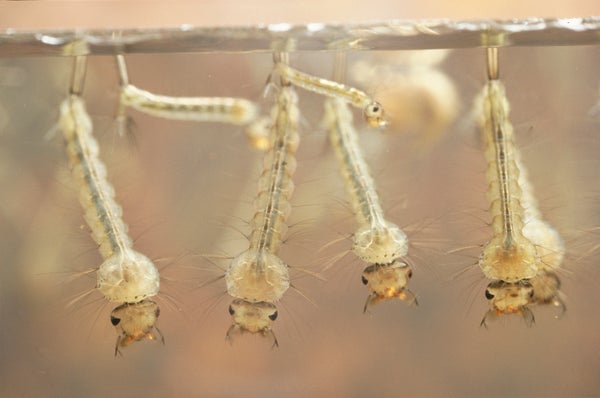Mosquito larvae will eat microscopic bits of plastic that can stay in their bodies as they metamorphose into adulthood, researchers have shown for the first time. This means they and similar insects could spread the plastic particles that contaminate aquatic ecosystems—where many bugs spend their infancy—to land predators such as birds or spiders, thus “polluting a whole new environment,” says Amanda Callaghan, an associate professor of zoology at the University of Reading in England.
Callaghan’s study, detailed this week in Biology Letters, is the latest in a flurry of research into the potential impacts of the minuscule bits of plastic that have accumulated in the environment from the seafloor to farm soil as larger plastic waste breaks down. These microplastics are tiny enough to be ingested by even the smallest creatures, raising the possibility they could accumulate up the food chain. Whether this is happening in the wild—and if it happens on a scale that could have significant effects in the overall environment—remains to be seen, however.
Many species, from earthworms to mussels, inevitably eat plastic particles. Callaghan wanted to see if mosquitoes would do so, and whether they would retain the pollutants throughout their life cycles. Her team exposed mosquito larvae to two sizes of fluorescent polystyrene particles (two and 15 microns, or about the size of an Escherichia coli bacteria and 1.5 human blood cells, respectively) and then put them in clean water. When the researchers dissected several larvae they found the microplastics in their guts. The team dissected more mosquitoes once they had developed into pupae, which do not feed, as well as adults—and still found microplastics inside the equivalent of the insects’ kidneys. “So what they’d eaten as a larvae stayed inside the gut system,” Callaghan says.
On supporting science journalism
If you're enjoying this article, consider supporting our award-winning journalism by subscribing. By purchasing a subscription you are helping to ensure the future of impactful stories about the discoveries and ideas shaping our world today.
The number of particles found did drop with each stage of development; Callaghan says this could suggest the mosquitoes are excreting some of what they eat in the larval stage and again as soon as they become adults. But further research would be needed to confirm that hunch.
As is often the case with microplastics research conducted in a lab, the amount of plastic to which the larvae were exposed is likely much larger than mosquitoes would encounter in the environment, says Martin Wagner, an ecotoxicologist at Norwegian University of Science and Technology who was not involved in the new study. The amount found in the mosquitoes was also relatively low, he notes. One of Wagner’s PhD students has performed an experiment similar to Callaghan’s—although with a species of midge and at lower concentrations of microplastic—and did not find the same lifelong retention, he says.
Callaghan says one of the next steps in this research will be environmental sampling of mosquitoes from areas polluted with microplastics, to see if they find the same evidence of transfer between life stages that they did in the lab. She also wants to see if this happens with other insects that go through such metamorphoses.
The team has found no indications microplastics are harming the survival rates of mosquitoes themselves. But the findings raise concerns larval mosquitoes could take up microplastics from the bottom of a pond, for example, and eventually transfer them to the land-based birds, bats and other animals that prey on the adult insects, sending the plastic particles up the food chain. “There’s no other route that they would pick up these plastics,” that would otherwise only be available to aquatic species, Callaghan says.
Microplastics building up in an animal’s gut could curb its appetite, potentially reducing its growth and reproduction—which has been shown to occur in some species. But unlike pollutants such as mercury, it is unclear how readily microplastics can escape the gut and reach other organs. And microplastics come in a wide array of sizes, shapes and polymer types, which could have equally diverse impacts. Wagner also points out mosquitoes and other animals are also exposed to many naturally occurring particles they cannot digest—but that they have adapted to deal with those, and it remains to be seen if microplastics will have a different outcome.
Callahan thinks it is unlikely mosquitoes would transfer microplastics to humans or other animals via their bites; for this to happen, the plastic particles would have to somehow work their way to the insects’ salivary glands. Rather, she says, “I think the human angle here is about the effect of humans—it’s about the effect the humans are having on ecosystems.”
